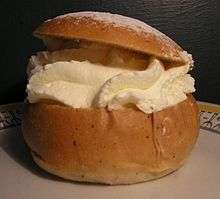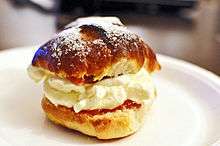Semla
A semla, vastlakukkel, laskiaispulla or fastlagsbulle/fastelavnsbolle is a traditional sweet roll made in various forms in Sweden,[1] Finland, Estonia, Norway, Denmark, the Faroe Islands and Iceland, associated with Lent and especially Shrove Tuesday in most countries, Shrove Monday in Denmark, parts of southern Sweden, Iceland and Faroe Islands or Sunday of Fastelavn in Norway. In Sweden it is most commonly known as just semla (plural: semlor), but is also known as fettisdagsbulle (lit. "fat tuesday roll"). In the southern parts of Sweden, as well as in Swedish-speaking Finland, it is known as fastlagsbulle (plural: fastlagsbullar; semla on the other hand means a plain wheat bun with butter, called "fralla" in Sweden). In Estonia it is called vastlakukkel. In Norway and Denmark it is called fastelavnsbolle. In Iceland, it's known as a bolla and served on Bolludagur. In Faroe Islands it is called Føstulávintsbolli, and is served on Føstulávintsmánadagur. Semla served in a bowl of hot milk is hetvägg (lit. "hot wall"). [2]
 Traditional Swedish semla | |||||||
| Alternative names | Laskiaispulla and Lent buns | ||||||
|---|---|---|---|---|---|---|---|
| Type | Sweet roll | ||||||
| Course | Dessert | ||||||
| Region or state | Northern Europe | ||||||
| Associated national cuisine | Sweden | ||||||
| Invented | 1500s | ||||||
| Serving temperature | Medium | ||||||
| Main ingredients | Wheat bread, whipped cream and almond paste | ||||||
| Ingredients generally used | Icing sugar | ||||||
| Variations | Hetvägg | ||||||
| 298 kcal (1248 kJ) | |||||||
| |||||||
| Similar dishes | Pulla and cardamom bread | ||||||
Etymology
The name semla (plural, semlor) is a loan word from German Semmel, originally deriving from the Latin simila, meaning 'flour', itself a borrowing from Greek σεμίδαλις (semidalis), "groats", which was the name used for the finest quality wheat flour or semolina. In the southernmost part of Sweden (Scania) and by the Swedish-speaking population in Finland, they are known as fastlagsbulle. In Denmark and Norway they are known as fastelavnsbolle (fastlagen and fastelavn being the equivalent of Shrove Tuesday). In Scanian, the feast is also called fastelann. In Finnish they are known as laskiaispulla, in Latvian as vēja kūkas, and in Estonian as vastlakukkel.
Sweden/Finland
.jpeg)

Today, the Swedish-Finnish semla[3] consists of a cardamom-spiced wheat bun which has its top cut off, and is then filled with a mix of milk and almond paste, topped with whipped cream. The cut-off top serves as a lid and is dusted with powdered sugar. Today it is often eaten on its own, with coffee or tea. Some prefer to eat it in a bowl of hot milk. In Finland, the bun is often filled with strawberry or raspberry jam instead of almond paste, and bakeries in Finland usually offer both versions. (Many bakeries distinguish between the two by decorating the traditional bun with almonds on top, whereas the jam-filled version has powdered sugar on top). In Finland-Swedish, semla means a plain wheat bun, used for bread and butter, and not a sweet bun. At some point Swedes grew tired of the strict observance of Lent, added cream and almond paste to the mix and started eating semla every Tuesday between Shrove Tuesday and Easter. Every year, at around the same time that the bakeries fill with semlor, the Swedish newspapers start to fill with semla taste tests. Panels of 'experts' dissect and inspect tables full of semlor to find the best in town.
Some bakeries have created alternative forms of the pastry, such as the "semmelwrap" formed as a wrap rather than the traditional bun, while others have added e.g. chocolate, marzipan, or pistachios to the recipe.[4]
In Finland and Estonia the traditional dessert predates Christian influences. Laskiaissunnuntai and Laskiaistiistai were festivals when children and youth would go sledding or downhill sliding on a hill or a slope to determine how the crop would yield in the coming year. Those who slid the farthest were going to get the best crop. Hence the festival is named after the act of sliding or sledding downhill, laskea. Nowadays laskiainen has been integrated into Christian customs as the beginning of lent before Easter.[5]
Norway

Fastelavnsbolle consists of a cardamom-spiced wheat bun which has its top cut off, and is then filled with whipped cream, topped with jam. The cut-off top serves as a lid and is dusted with powdered sugar. The buns are served at Sunday of Fastelavn (Shrove Sunday), but were previously associated with Shrove Tuesday.[6]
Denmark/Iceland/Faroe Islands
The version sold in Danish bakeries on or around Shrove Monday is rather different, made from puff pastry and filled with whipped cream, a bit of jam and often with icing on top. At home people may bake a version more similar to a usual wheat roll, mixing plain yeast dough with raisins, succade and sometimes candied bitter orange peel.
In Iceland it is done in a similar way but in place of puff pastry more common is the choux pastry version.
In Icelandic Shrove Monday is called bolludagur (bun day), named after the pastry.
in Faroe Islands it is done with choux pastry, and filled with vanilla cream, whipped cream and jam, and topped with chocolate icing.
History
The oldest version of the semla was a plain bread bun, eaten in a bowl of warm milk. In Swedish this is known as hetvägg, from Middle Low German hete Weggen (hot wedges) or German heisse Wecken (hot buns) and falsely interpreted as "hotwall".[7] The semla was originally eaten only on Shrove Tuesday, as the last festive food before Lent. However, with the arrival of the Protestant Reformation, the Swedes stopped observing a strict fasting for Lent. The semla in its bowl of warm milk became a traditional dessert every Tuesday between Shrove Tuesday and Easter. Today, semlor are available in shops and bakeries every day from shortly after Christmas until Easter. Each Swede consumes on average four to five bakery-produced semlor each year, in addition to any that are homemade.[8]
King Adolf Frederick of Sweden died of digestion problems on February 12, 1771 after consuming a meal consisting of lobster, caviar, sauerkraut, smoked herring and champagne, which was topped off by fourteen helpings of hetvägg (semla), the king's favorite dessert.
This was the sweet chosen to represent Finland in the Café Europe initiative of the Austrian presidency of the European Union, on Europe Day 2006.
References
- "Semlor - Recept - Semlebullar". recepten.se.
- http://blog.ingredientmatcher.com/recipe-swedish-semlor-fastlagsbullar-hetvagg-sweet-cream-bun-eaten-mardi-gras/
- "Älskade semla!". www.norrmejerier.se.
- "The semla – more than just a bun". sweden.se. Retrieved 23 February 2019.
- "Helsinki City Museum: Winter - Laskiainen". Archived from the original on January 14, 2012.
- "Fastelavnsboller - Boller - Oppskrifter - Mollerens Web". 2013-03-31. Archived from the original on 2013-03-31. Retrieved 2018-02-09.
- "Swedish semla: more than just a bun". Archived from the original on June 6, 2011.
- "Aftonbladet: Svenska folket laddar för fettisdagen".